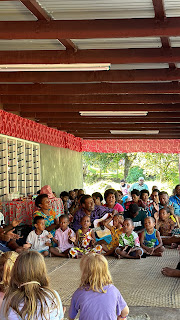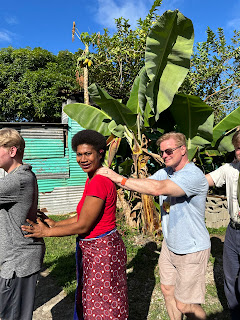We had a busy day on our 10th day in Fiji. Dee, the house manager and chef for our rental property, offered to accompany us to several local sites/attractions. We went to KokoMana Chocolate Factory, Nakama Hot Springs, Nawi Island Marina, shopping in downtown Savusavu, and a visit to Nukubalabu Village.
KokoMana is a small chocolate factory. I was fascinated by the process of starting with cocoa seeds (the KokoMana staff say cocoa not cacao trees) and seeing how they are grown and processed to make chocolate. We were told KokoMana makes about 250 bars/packages a week. We started our tour learning about the different varieties of cocoa trees on the property and how their fruit is transformed into chocolate.
KokoMana grows four different varieties of cocoa trees. Larger cocoa fruit have a higher cocoa butter content. The trees that have smaller fruit, produce more fruit per tree than the larger fruit trees. They combine the different varieties of cocoa beans to make their chocolate.
Cocoa nibs are put in this grinding machine and it is set to grind for 12 to 15 hours to turn the nibs into smooth chocolate.After learning a bit of the history of KokoMana, Joeli, the farm supervisor, took us on a tour to see the trees and harvesting process. The KokoMana farm was started on an abandoned cultivation area in 2013. By 2016 there were 200 thriving cocoa trees on the land. Then, Cyclone Winston (a category 5 storm) blew all of the trees down. The owners were able to stand most of the trees back up and they continued to grow. At the end of 2020 another category 5 storm flattened the area again. They stood the trees back up and kept working. Now, there are almost 500 mature trees on the property.
It takes three years from seed for a tree mature enough to produce flowers (bottom of pic) that eventually turn into cocoa fruit. The cocoa fruit turns purple (top right of pic) at about two months and then takes 6 months from flower to ripe yellow fruit.
After the tour of the grounds, we went back inside for a tasting of the different varieties of bars KokoMana makes. The chocolate is made with cocoa nibs and Fiji cane sugar. They do not add emulsifiers, preservatives, or stabilizers to their chocolate. They do add natural ingredients for flavor. We each purchased a package of chocolate at the end of the tour. Boogs and I both chose chocolate covered ginger. My husband got chocolate with condensed milk.
It was really neat to learn how KokoMana tries to make chocolate as sustainably as possible. They were having problems with tree rats eating their fruit. The local government told them they could use rat poison at the base of the trees. KokoMana did not want to use poison on their property so they brought in four cats to take care of the rat problem.
Kokomana gathers about 1000 cocoa fruits a month. They use a cement block to split open the fruit.
Inside, the cocoa beans are surrounded by a pod and covered in fruit. We got to taste the fruit surrounding the cocoa pod, it kind of tasted like passion fruit.
They take the fruit and leave it out for fruit flies for a few days. The fruit flies are a necessary part of the fermentation process because they (somehow) help add yeast to the fermentation process. Then the seed pods are left to ferment under banana leaves for about 6 days before being moved to the drying racks for three weeks.After the tour of the grounds, we went back inside for a tasting of the different varieties of bars KokoMana makes. The chocolate is made with cocoa nibs and Fiji cane sugar. They do not add emulsifiers, preservatives, or stabilizers to their chocolate. They do add natural ingredients for flavor. We each purchased a package of chocolate at the end of the tour. Boogs and I both chose chocolate covered ginger. My husband got chocolate with condensed milk.
After leaving KokoMana we stopped back by the rental property to pick up an egg, a spoon, and a small bowl. Dee told me we would need those things at Nakama Hot Springs to boil an egg.Dee put the egg into the hot spring water and told us to leave it there while we looked around.
There were two spots where the hot springs were bubbling up. Dee said locals cook their meals in pots covered with tarps in the hot water. She and her family come by and place chicken in a pot in the springs and then go to a nearby park while it cooks. Then they come back to the springs to eat at the picnic tables near the springs. She said it is a gathering place for locals to share food and visit with each other.
A few minutes later, the egg was boiled.
I am not a fan of soft boiled eggs, but Boogs likes them. We all ate a little bit of it.After we left the springs, we took a boat taxi over to Nawi Island Marina and had lunch at Skipper's Bar. Boogs was very happy with his fish and chips.
Boat ride across to Nawi.
Outdoor seating area at Skipper's Bar.
The marina is really pretty. It was opened in 2022 and was built has a haven for boats during cyclone season. "Nestled safely between three islands, Nawi, Korovesa and Nawi Lailai, it is the state of the art, custom designed Marina, engineered to provide year-round mooring." This picture is from Super Yacht News. You can see how well the boats are protected. The marina is set up with restaurants, a laundry services, swimming pool, fuel services, restrooms & showers, and retail shops.
The village elders greeted each visitor with a simple Salusalu, a Fijian lei. Villagers sang a welcome song to their guests.
The village elders organized the visitors before walking us through the village to the community center. They asked for men and boys to walk ahead of women and girls. Women visitors had to have their shoulders and knees covered to enter the village. Once we reached the community center, a prayer was said and the kava the visitors brought was presented to the village chief.We really enjoyed listening to the singing. The villagers were very welcoming and seemed happy.
Visitors were asked to dance with the villagers. My husband is on the left in this photo.
After the dancing, there were several different demonstrations - making a basket, opening coconuts in various ways, and information about village life.
Dee told us that the Chief of the Nubalavu Village is one of the highest chiefs on the island. She askes the Chief if it would be possible to get a picture with him. There are about 300 people in the village. This village holds the title of Tui Na Savusavu, the highest title in the land of Savusavu.
Boogs joined in too. He looked a little nervous while dancing.
The dance transformed into a giant conga line for several minutes before we returned to our seats to see the traditional dances of the villagers.
After the dancing, there were several different demonstrations - making a basket, opening coconuts in various ways, and information about village life.
This basket was made in about 10 minutes.
After the singing, dancing, and demonstrations, we shopped the tables of handmade items for sale. My husband bought a war club. Boogs and I had already bought souvenirs when we went to the Vuodomo village and waterfall.
I enjoy talking with people and learning about their lives. I had a conversation with a women who is my age but is also two years older than me. While we were talking about our kids, we discovered we were born in the same year. When she was 16, she got pregnant. She told me that is not something that was allowed and the father of her child had an uncle who worked in the government offices. The uncle changed the year on her birth certificate from 1970 to 1968 so that her child's birth would be proper. She had to leave school and get married, then "properly" have her child. To this day, she is still legally two years older than she really is. Another lady told me about her life. She is one of 17 children. She is in her mid-30s and has four children of her own. She said her husband does not like to work, so she is "the strong one for the family". She was born in Savusavu, then went to Nadi at 18 to work in a resort. She worked in the kitchens at a resort and the head chef encouraged her to take classes and get a culinary certificate. She said it took her two years to finish the program, but then she could work as a chef. She returned to Sasvusavu to work. She married and started a family. Before she had kids, she said she was on the Savusavu rowing team. She misses the joy of that but wants to work hard to do what is best for her children.
We had such a great day learning more about the culture of Fiji. I am glad my husband was feeling better today and got to enjoy the sights of Savusavu. By evening, I think I started to catch his cold and was not feeling so great. We had a quiet evening at our rental property and went to bed early.





























No comments:
Post a Comment